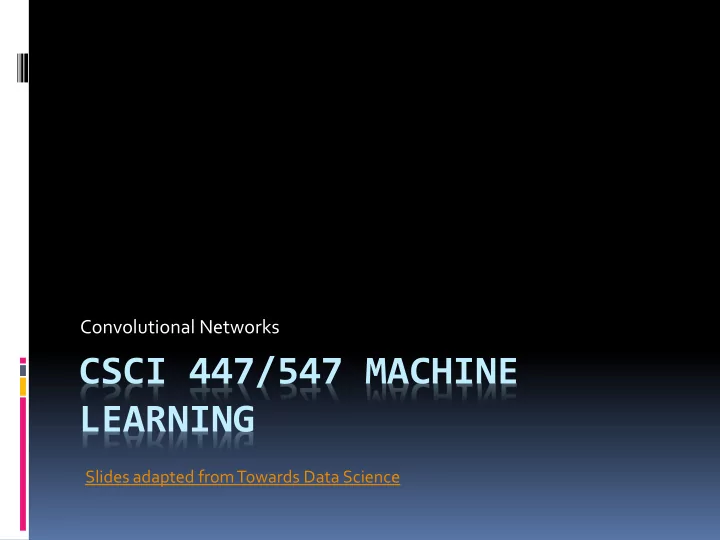

Convolutional Networks CSCI 447/547 MACHINE LEARNING Slides adapted from Towards Data Science
Outline Overview Architecture Intuition Example Visualization
Overview Detects low level features Uses these to form higher and higher level features Computationally efficient Convolution and pooling operations Parameter sharing Primarily used on images, but has been successful in other areas as well
Architecture “Several” convolutional and pooling layers followed by fully connected neural network layers
Architecture Convolution Filter or kernel applied to input data Output is a feature map Based on the type of filter used Filter is slid over area of input Values in filter multiplied by values in input and then summed together to produce one output
Architecture Receptive Field Convolution – 2D
Architecture Convolution – 3D
Architecture Non-Linearity Results of convolution operation passed through an activation function e.g. ReLU Stride How much the filter is moved at each step Padding – or not Fill external boundary with 0’s or neighboring value
Architecture Pooling Reduces dimensionality Most common is max pooling, can use average pooling also Still specify stride
Architecture Hyperparameters Filter size Filter count Stride Padding
Architecture Fully connected layers Same as a deep network Flatten output of convolution and pooling to get vector input Training Backpropagation with gradient descent More involved than fully connected networks https://www.jefkine.com/general/2016/09/05/backpropag ation-in-convolutional-neural-networks/ https://grzegorzgwardys.wordpress.com/2016/04/22/8/ Filter values are weights, and are adjusted during backpropagation
Intuition Convolution + pooling layers perform feature extraction Earlier layers detect low level features Later layers combine low level into high level features Fully connected layers perform classification
Intuition Perspectives Convolution in Image Processing Weight Sharing in Neural Networks
Intuition: Image Processing Convolution Operators
Intuition: Weight Sharing
Example Example is for Dogs vs Cats data from Kaggle
Example Dropout Prevent overfitting Temporarily disable a node with probability p Can become active at the next pass p is the “dropout rate” – 0.5 is a typical starting point Can be applied to input or hidden layer nodes
Example Model Performance Overfitting, despite using dropout
Example Data Augmentation Using existing examples to create additional ones Done dynamically during training Transformations should be learnable Rotation, translation, scale, exposure adjustment, contrast change, etc.
Example Data Augmentation
Example Updated Model Performance
Visualization
Summary Overview Architecture Intuition Example Visualization
Recommend
More recommend